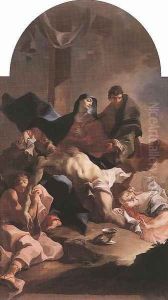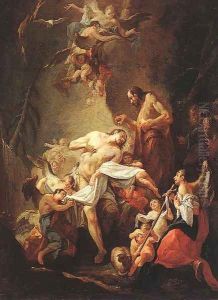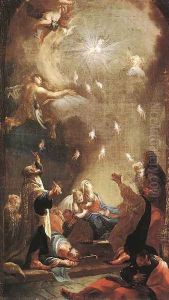Joseph Ignaz Mildorfer Paintings
Joseph Ignaz Mildorfer, also known as Ignaz Johann Mildorfer, was an Austrian painter born on November 13, 1719, in Innsbruck. He was a representative of the late Baroque and early Rococo periods in art. Mildorfer was the son of a painter, and his father's occupation had a significant influence on his career choice. He likely received his first artistic training from his father, which was common in the artist families of the period.
Mildorfer's work is characterized by dynamic compositions, a vivid use of color, and a flair for dramatic expression, all of which are hallmarks of the Baroque style. He was particularly known for his frescoes and altarpieces. His work often featured religious themes, as was typical of the era, and he served the church through his art by contributing to the decoration of various religious buildings.
In 1731, at the age of 12, Mildorfer moved to Vienna, where he entered the Academy of Fine Arts. His studies there further honed his skills, and he was influenced by the rich artistic environment of the Habsburg capital. After completing his education, he embarked on a successful career as a painter.
Mildorfer became a court painter and later a professor at the Academy of Fine Arts in Vienna. He held this position for many years, and through it, he was able to influence a new generation of artists. His paintings during this period continued to reflect the grandeur and emotions of the Baroque style, but also began to incorporate lighter elements of the Rococo movement, which was gaining popularity at the time.
Joseph Ignaz Mildorfer's works can be found in various churches and museums, including the Kunsthistorisches Museum in Vienna. His contributions to the frescoes of the Imperial Palace of Hofburg in Vienna and other ecclesiastical buildings in Austria are particularly noted for their artistry. His legacy is that of an artist who bridged the gap between the high drama of the Baroque and the ornate elegance of the Rococo.
Mildorfer's life came to an end on December 8, 1775, in Vienna. Despite his death, his works continue to be appreciated for their emotional intensity and technical virtuosity. They remain an integral part of the artistic heritage of Austria's Baroque period and provide insight into the transition towards the Rococo style.


